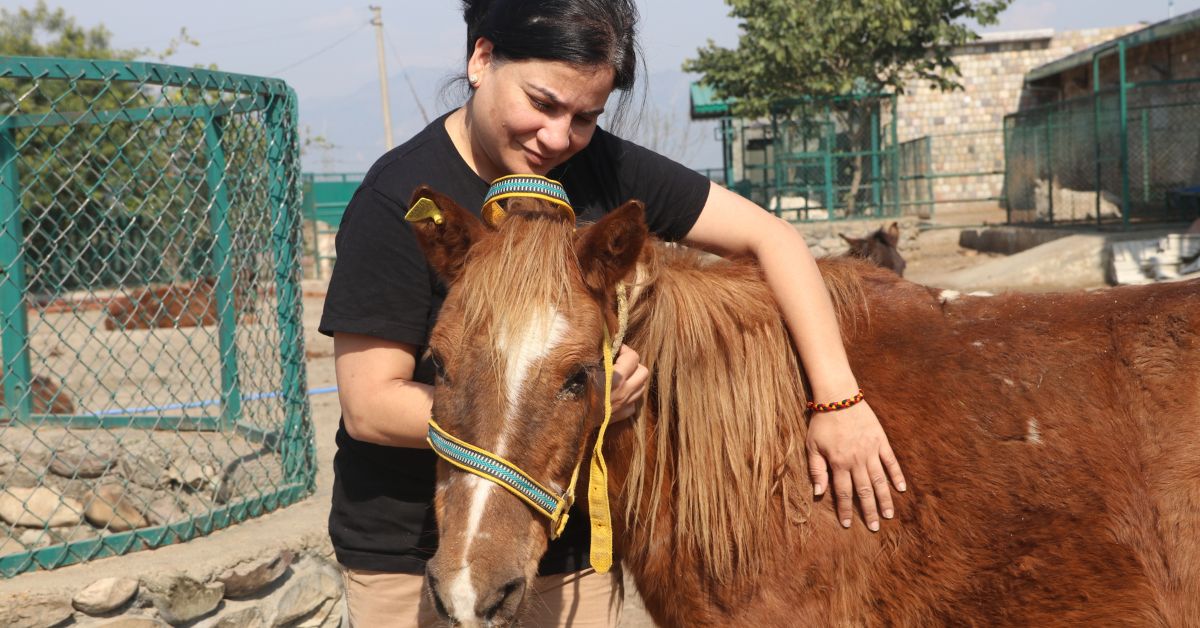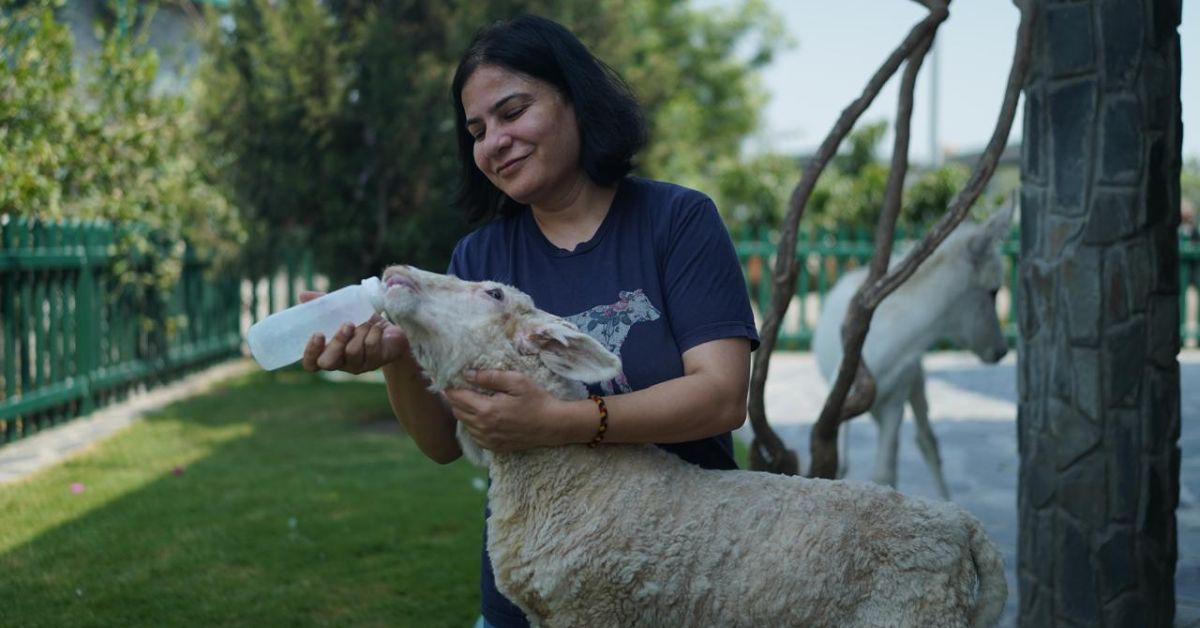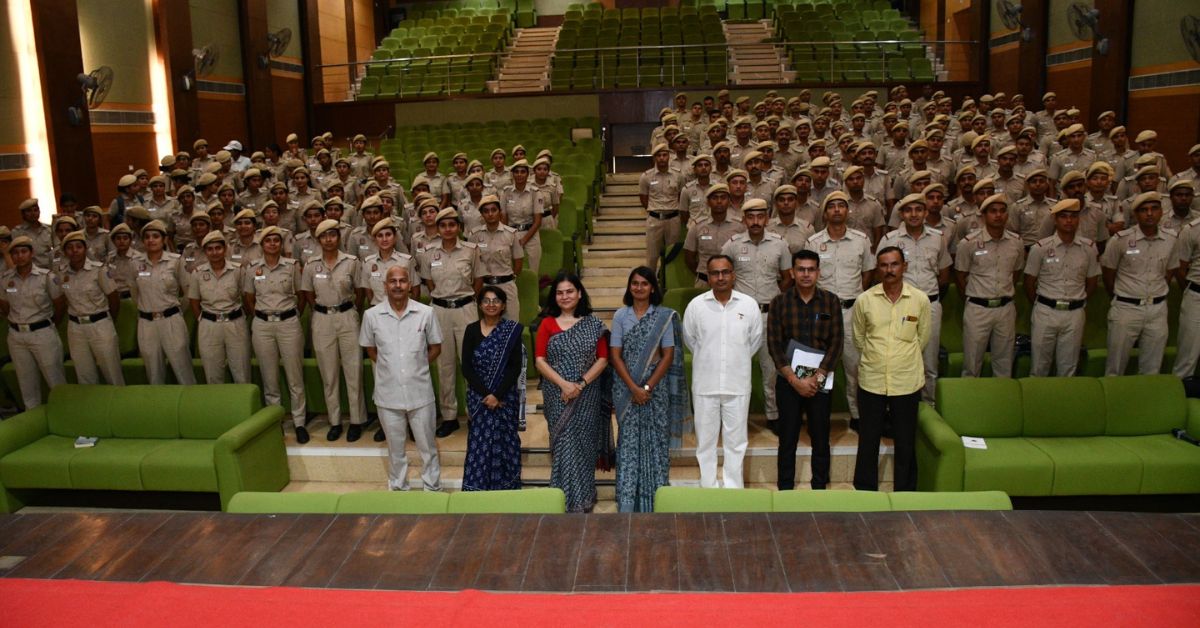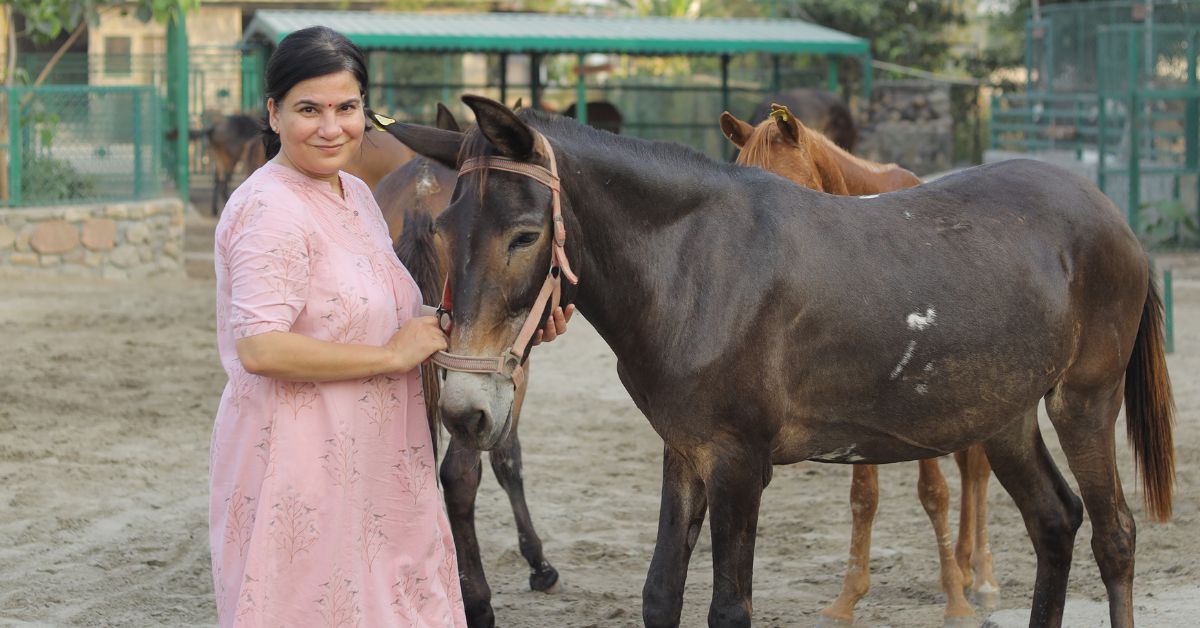She Lost Her Beloved Pet — Now She’s Saving Thousands of Animals on Pilgrimage Routes From Cruelty
Every year, devoted travellers set out on pilgrimage routes in bustling, picturesque landscapes of the country, some on foot, some on the back of equines. Thousands of equines — horses, mules, and donkeys — are burdened not only by their heavy loads but also by exhaustion, dehydration, and malnutrition. In the holy air, where one seeks peace, these sentient beings fight their silent battles against neglect and cruelty.
“A particularly distressing incident comes to my mind: two horses, pulling a cart, collapsed from sheer exhaustion near Dehradun. Instead of empathy, their owner resorted to desperate measures. He lit paper near their noses to induce panic and force them back to work. Such is the plight of these weary travellers, working on the brink of death just to survive another day,” shares Gauri Maulekhi with The Better India.
She further highlights that the plight of equines on pilgrimage routes presents a challenging and heartbreaking scenario. “About 40,000 to 50,000 equines are used on popular pilgrimage routes, such as Chardham and Vaishno Devi, where they face neglect and abuse.”
In her words, “dying out of exhaustion is the worst kind of death,” and her endeavours strive to eradicate such inhumane practices.
 Gauri’s initiatives have rescued thousands of equines from harsh pilgrimage routes.
Gauri’s initiatives have rescued thousands of equines from harsh pilgrimage routes.
A torchbearer of animal compassion, when Gauri learnt about the incident and suffering, she could not stand idly. Driven by empathy and determination, she approached the situation with a strategic resolve that promised change.
She didn’t just speak up; she took action. Taking her fight to the legal system, she caught the eye of the Uttarakhand High Court. From there, she pushed tirelessly for change, helping set a precedent for how equines should be treated. More than just a protestor, she wanted to make sure that these animals were getting the care they deserved.
She set up the sole equine sanctuary in Uttarakhand to provide refuge to disabled, injured, and abandoned animals. “Collaborating with local administrations, we ensured that only healthy, registered equines serve these routes, and that effective complaint systems are in place where previously there were none,” she adds.
Gauri’s work is not merely about rescue and rehabilitation; it’s about restoring dignity to the lives of equines, and reminding the world that compassion must extend to all beings.
Beyond rescue: campaigns that change the status quo
It was during the late 1990s when young Gauri faced a profound personal tragedy that set her on this transformative journey. It was the untimely death of her beloved pet due to the lack of accessible veterinary care that opened her eyes to the world of animal welfare.
This heart-wrenching experience, along with her yearning to do something larger than life, planted the seed for what would become a lifelong dedication to the voiceless residents of our planet.
 Beyond rescue and rehabilitation, Gauri strives to restore dignity to the lives of animals.
Beyond rescue and rehabilitation, Gauri strives to restore dignity to the lives of animals.
She’s not just driven by emotion. She’s standing up to apathy and ignorance, the quiet reasons why so many animals are still suffering.
Starting her journey as a volunteer, Gauri’s initial steps were exploratory rather than decisive. Over 18 years, she juggled various careers — from teaching to radio jockeying, from software to theatre — but always returning to the humble shelter where her earnings found a meaningful end.
It didn’t happen overnight. It was a slow build where a series of small but meaningful wins for animals led her to start People for Animals, Uttarakhand in 2012. For her, it wasn’t just about rescue work. She wanted to tackle the bigger issues too, like outdated beliefs and broken systems that kept animals at risk.
“Before our interventions, Uttarakhand was marred by unchecked animal sadism — over a lakh animals were sacrificed annually in temple rituals, animal birth control was non-existent, and the forest department lacked even a single veterinarian. By building alliances with the government and judicial systems, we set up wildlife rescue centres and animal birth control centres,” she points out.
Her approach is strategic while being rooted in compassion. Through training police officers, administrators, and veterinary officials, she equips the state machinery to handle animal welfare with empathy and efficiency.
“We emphasise a collaborative approach and work closely with officials to improve conditions on the ground. This has included deploying a team to assist with health checks and ensuring that only registered, healthy equines are allowed to serve on pilgrimage routes. Such collaborations ensure that our strategies outlast a direct involvement and create a sustainable impact structure,” she adds.
 Gauri’s work with 5,000 sensitised officials aims for improved animal welfare through compassion and strategic advocacy.
Gauri’s work with 5,000 sensitised officials aims for improved animal welfare through compassion and strategic advocacy.
Dr Satish Joshi, Chief Veterinary Officer of Dehradun, has been pivotal in advancing animal welfare in Uttarakhand with Gauri’s support for 20 years. “Their training included an in-depth understanding of the Animal Husbandry Act, the Animal Cruelty Act, and the necessary documentation for enforcement,” he says. In India, the Prevention of Cruelty to Animals Act of 1960 addresses cruelty towards equines, encompassing various forms of animal abuse.
Dr Satish, continues to share, “I was stationed in Vikas Nagar where active cooperation with the police and administration was necessary due to frequent cases of animal rights infringements. As veterinarians, having complete information about regulatory procedures has been vital. The support we received from Gauri was essential in ensuring that operations were conducted legally and respectfully.”
Dr Satish says the government’s role is of paramount importance as they conduct disease surveillance, random sampling for equine influenza and glanders, and provide requisite treatments. “Despite the challenges, particularly in regions like Kedarnath and Yamunotri, our veterinary officers, alongside Gauri’s team, sustain commendable efforts to safeguard animal welfare. Our team in Uttarakhand’s Animal Husbandry Department remains dedicated and skilled, often overcoming immense obstacles to deliver essential care,” he adds.
A shortage of skilled advocates led to the inception of the AHIMSA Fellowship, a programme designed to train the next generation of animal welfare experts. The fellowship not only imparts legal knowledge but emphasises experiential learning and strategic communication with governments and industries.
 As part of the fellowship, 59 fellows have been trained to work in animal protection sectors.
As part of the fellowship, 59 fellows have been trained to work in animal protection sectors.
This eight-month fellowship stands out by training individuals in their own states, empowering them with skills to address local issues while collaborating with a national network of mentors and experts.
Delhi-based Sanna Singh, who has been committed to animal welfare since 2019, was part of 2023-24 cohort. Sharing her experience, Sanna says, “The fellowship begins with online sessions followed by in-depth, in-person workshops, providing participants with comprehensive knowledge of animal welfare laws and strategies to influence policy changes. I learnt to leverage my skills to work with government authorities, tackling large-scale issues within the dairy and pig industries.”
The fellowship isn’t just about learning theory. It gives fellows hands-on projects and real assignments they can work on in their own regions. This way, they’re doing more than just theoretical learning. Instead, they’re making a real impact from the start. And the best part? The work doesn’t stop when the fellowship ends. Just like Sanna, many continue pushing for change long after the program, helping improve lives for countless animals.
“I first got involved in animal welfare around 2019, in the initial phase of the COVID-19 pandemic, driven by a longstanding passion for the social sector. For me, it felt like a calling. The AIMSA Fellowship allowed me to take this passion further by providing the right mentorship and direction,” she says.
“Prior to this, my efforts were focused on rescuing individual animals like cats and dogs. However, the fellowship has empowered me to work on a much larger scale, influencing policies that can improve the lives of countless animals. It taught me the importance of understanding and leveraging laws, and although the process requires patience, the potential for lasting impact is significant,” she adds.
 Gauri works to ensure that these animals get the care they deserve.
Gauri works to ensure that these animals get the care they deserve.
As part of the fellowship, 59 fellows have been trained to work in animal protection sectors. As per their records, about lives of 50 lakh animals have been impacted, over 5,000 govt officials sensitised, and at least 50,000 volunteers have been trained in other training sessions.
While these stats suggest that the impact is significant, Guari views this as merely “scratching the surface”. Her aspirations go beyond rescue and rehabilitation; she envisions a paradigm shift in how society perceives animal welfare.
Commenting on the distressing incident of those two horses near Dehradun, Gauri says: “They now live with us, happy and healthy, still maintaining their close bond with one another. However, many such equines experience death through exhaustion, which is unimaginably cruel and akin to being worked to death — a fate no being deserves.”
“But this is the grim reality for many of these animals, and there are far too few that I can personally assist. Therefore, we conceptualised the Fellowship to extend this help and awareness across the globe, reaching everyone with the power to make a difference,” she urges.
Edited by Saumya Singh; All images courtesy: People for Animals, Uttarakhand & PFA-PPF
News